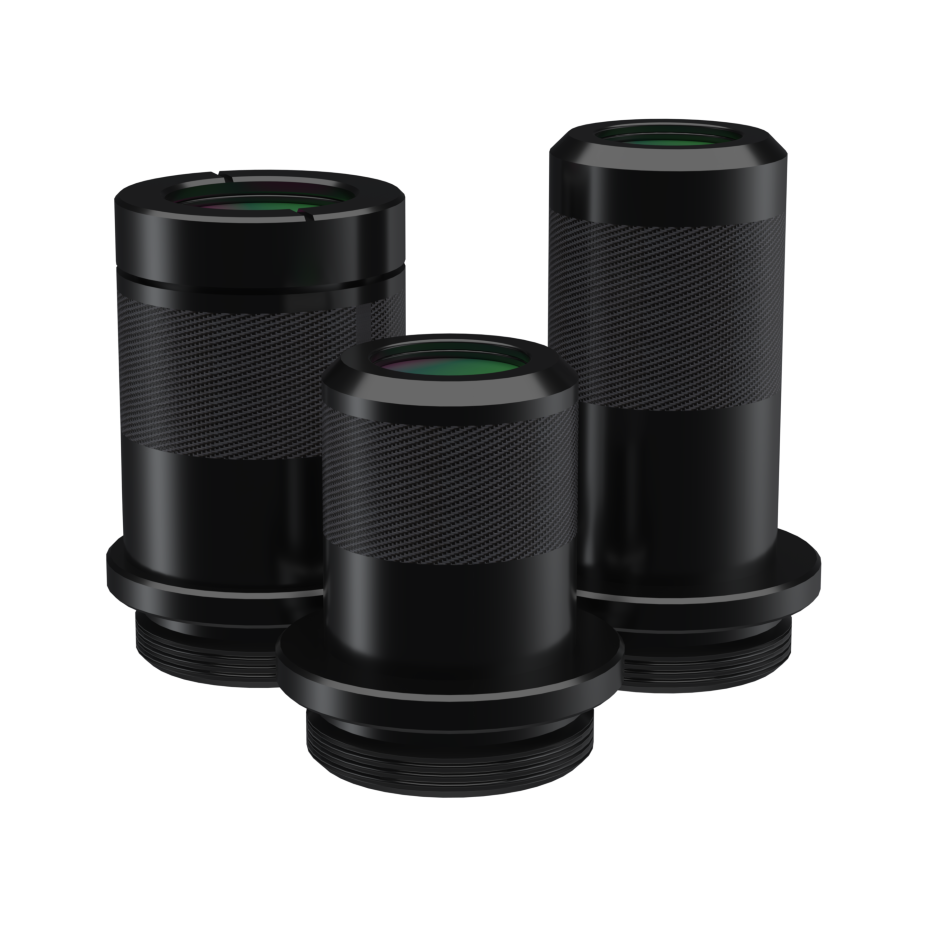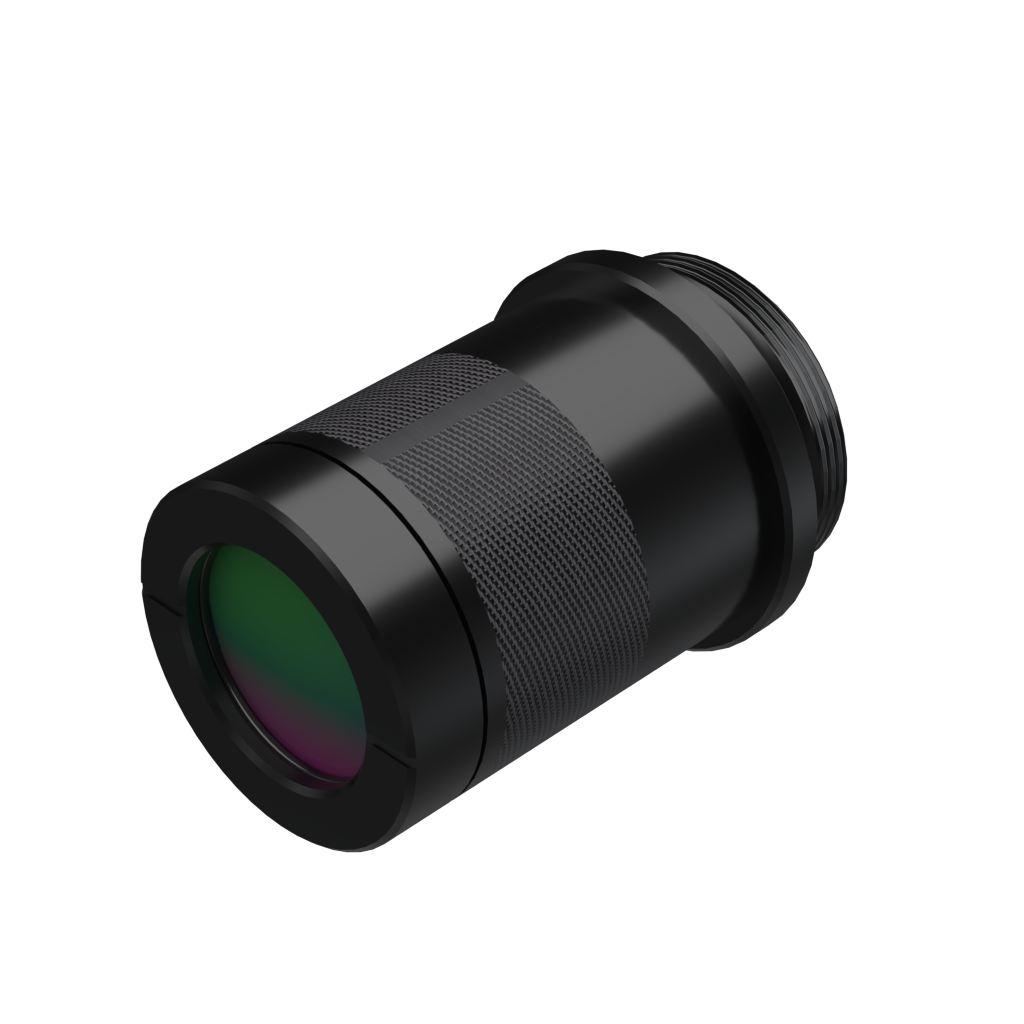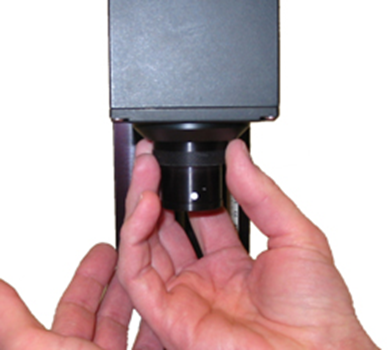
LW320-12 Lenses
We developed three radiometric LW320-12 lenses, enabling microscopic temperature measurement of features down to 3µm. Lenses are manufactured from Germanium, Zinc Selenide, and Zinc Sulfide with anti-reflective coatings for maximum transmission in the long wave infrared region. Each lens is designed for maximum sensitivity, long working distance, and with minimum distortion for clear, precise imaging. The threaded interface reduces the space required to attach the lens while maximizing thermal uniformity between the lens and camera body to maintain the high measurement accuracy.
Applications
- Microscopic temperature measurement and analysis of features down to 3µm in size
Overview
Comprehensive Calibration
Each lens is calibrated while installed on the camera, resulting in unsurpassed accuracy and measurement uniformity across the entire field-of-view.
Included Components
- Shock resistant carrying case
Included In
Required Products
Related Products

LW320-12 10 Micron Lens
PN0931
Optimized for high spatial resolution, this fixed-focus lens provides 10µm/pixel spatial resolution and 3.2 x 2.4 mm field-of-view at a working distance of 10 mm.
Application: Imaging small devices and samples with features down to 10µm in size

LW320-12 5 Micron Lens
PN0930
Optimized for high spatial resolution, this fixed-focus lens provides 5µm/pixel spatial resolution and 1.6 x 1.2 mm field-of-view at a working distance of 4.9 mm.
Application: Imaging small devices and samples with features down to 5µm in size

LW320-12 3 Micron Lens
PN0929
Optimized for high spatial resolution, this fixed-focus lens provides 3µm/pixel spatial resolution and 0.96 x 0.72 mm field-of-view at a working distance of 4.2 mm. Although we calibrate the 3µm lens, there is some diffraction that causes some energy to bleed into adjacent pixels. Therefore, accurate temperature measurements cannot be made between two 3 x 3 µm areas that are adjacent to each other. However, you can certainly distinguish features of 3µm. A Lock-in thermography test is a differential type of analysis and therefore, can localize hotspots down to 3 x 3 µm.
Application: This lens is typically used in differential type measurements, both spatially and temporally, in very small areas. See the USAF Chart comparison under Specifications to view the lens's performance.
Specifications
Optics
Lens |
IS320 10 Micron Lens |
IS320 5 Micron Lens |
IS320 3 Micron Lens |
Pixel Resolution
|
10 µm |
5 µm |
3 µm |
Focus
|
Fixed |
Fixed |
Fixed |
Sensitivity | <50mk | <100mk | <200mk |
Working Distance
|
10 mm |
4.9 mm |
4.2 mm |
Field of View
|
3.2 x 2.4 mm |
1.6 x 1.2 mm |
0.96 x 0.72 mm |
Focal Length
|
40.3 mm |
8.3 mm |
10.5 mm |
Numerical aperture | 0.6 | 0.7 | 0.75 |
Working F/#
|
1.09 |
1.41 |
2.62 |
Object Space NA |
0.39 |
0.60 |
0.65 |
Depth of Field |
±40µm |
±25µm |
±15µm |
Measurement
Calibration Range †
|
Low range: 0 to 80°C * |
Low range: 0 to 100°C * |
Low Range 0 to 140°C * High range: 0 to 300°C |
Sensitivity (NETD) ‡
|
Low range: < 40 mK (60 Hz) |
Low range: < 60 mK (60 Hz) |
< 100 mK < 200 mK |
Accuracy
|
Low range: ± 2°C |
Low range: ± 3°C |
Low range: ± 4°C |
* Micros low range calibrations are optimized for highest sensitivity and may have reduced calibration range.
† The calibration range stated in the specification indicates the range of black-body temperatures used during calibration. Temperature measurements outside of the stated range may be able to be performed but may not meet the specified measurement accuracy.
‡ Noise Equivalent Temperature Difference (NETD) specifies the smallest temperature difference that can be detected. The value stated is NETD at 60 Hz frame rate. Activating real-time image averaging can improve NETD but will increase the measurement response time.
§ whichever is greater
Optical Magnification Comparison
Optical magnification is calculated by dividing the sensor pixel size (12µm) by the lens image pixel size.
|
Image pixel size |
Optical Magnification
|
| 10µm |
12/10 = 1.2x |
| 5µm |
12/5 = 2.4x |
| 3µm |
12/3 = 4x |
Width of a line in micrometers in USAF Resolving Power Test Target 1951
|
|
Group Number | -2 | -1 | 0 | 1 | 2 | 3 | 4 | 5 | 6 | 7 | 8 | 9 |
|
Element
|
|
|
|
|
|
|
|
|
|
|
|
|
|
| 1 | 2000.00 | 1000.00 |
500.00 |
250.00 |
125.00 |
62.50 |
31.25 |
15.63 |
7.81 |
3.91 |
1.95 |
0.98 |
|
| 2 |
|
1781.80 |
890.90 |
445.45 |
222.72 |
111.36 |
55.68 |
27.84 |
13.92 |
6.96 |
3.48 |
1.74 |
0.87 |
| 3 |
|
1587.40 |
793.70 |
396.85 |
198.43 |
99.21 |
49.61 |
24.80 |
12.40 |
6.20 |
3.10 |
1.55 |
0.78 |
| 4 |
|
1414.21 |
707.11 |
353.55 |
176.78 |
88.39 |
44.19 |
22.10 |
11.05 |
5.52 |
2.76 |
1.38 |
0.69 |
| 5 |
|
1259.92 |
629.96 |
314.98 |
157.49 |
78.75 |
39.37 |
19.69 |
9.84 |
4.92 |
2.46 |
1.23 |
0.62 |
| 6 |
|
1122.46 |
561.23 |
280.62 |
140.31 |
70.15 |
35.08 |
17.54 |
8.77 |
4.38 |
2.19 |
1.10 |
0.55 |
Figure 1: USAF 1951 chart from 10µm lens perspective
Figure 2: USAF 1951 chart from 5µm lens perspective
Figure 3: USAF 1951 chart from 3µm lens perspective
Setup
Delicate Lenses: Optotherm lenses have glass-like properties and can be scratched, chipped, or shattered if mishandled. Additionally, there is a delicate coating on the surface of the lens to maximize transparency of long wavelength energy. Therefore, avoid touching the lens elements with your hands or with any hard or rough materials and handle them using the knurled installation grip.
Installing a Lens
While installing the lens, use both hands to prevent accidentally dropping the lens.
- Remove the new lens from the lens case.
- Remove the front and back lens protection caps and place them back in the lens case.
-
The lens threads into the front of the camera.
Lens Install: The lens threads into the front of the camera. Make sure there is no dirt or grit on the threads prior to installing a lens.
- Grasp the knurled grip and orient the threads of the lens into the threaded front of the camera. Make sure the lens is not angled. While gently pressing the lens against the camera, twist the lens clockwise (looking at the front of the camera) to thread the lens into the camera. Thread the lens until it is securely seated.
Lens Temperature: When a new lens is installed, you may need to wait a few minutes until an equilibrium temperature is reached between the new lens and camera to conduct accurate temperature measurements.
Removing a Lens
- Make sure the camera is aimed horizontally or downward to prevent dust or debris from entering the lens housing and damaging the camera detector.
-
Start Thermalyze and press the Capture Images button
 to open the camera shutter.
to open the camera shutter.
- Using both hands to prevent accidental dropping the lens (see Figure 2), grasp the knurled lens grip and gently twist the lens counterclockwise to unthread the lens and then slowly withdraw the lens from the camera. Place the lens protection caps on both ends of the lens and place the lens into the lens case for protection. Caution: Do not touch the lens glass during this procedure.
Figure 2: Removing a Lens
Operation
Lens Focusing
All microscopic lenses have fixed focus and therefore the entire camera must be moved toward/away from an object using the Vertical Stage to focus the image.
Lens Contact: Microscopic lenses have short working distances. Therefore, to avoid damaging the lens, use caution when lowering the camera using the Vertical Stage to prevent contacting the lens with the unit under test or system component.
Maintenance
Lens Cleaning
Delicate Lenses: Please follow these instructions carefully to avoid lens damage.
Precautions
To protect the lens from damage, follow these guidelines.
- Never touch the lens with hard or abrasive objects.
- Do not use solvents to clean the lens. Solvents may remove the lens coating.
- Do not use lens cleaning papers or tissues to wipe the lens. These products are abrasive and will scratch the lens.
Lens Cleaning Kit
This is provided with your camera and includes the following components.
- Air bulb blower
- Lens cleaning solution
- Wiping cloth
- Cotton swabs
Lens cleaning Procedure
Excessive dust or debris on the camera lens can reduce measurement accuracy. To clean the lens, follow this procedure.
- Use the air bulb blower and brush to remove any dust or loose grit from the lens.
- Put a few drops of the cleaning solution on the cloth and gently wipe across the lens (not round and round). Use only enough pressure to remove the smudges (do not rub hard).
- Use the cotton swabs for tougher lens grime but avoid rubbing the same spot over and over.
